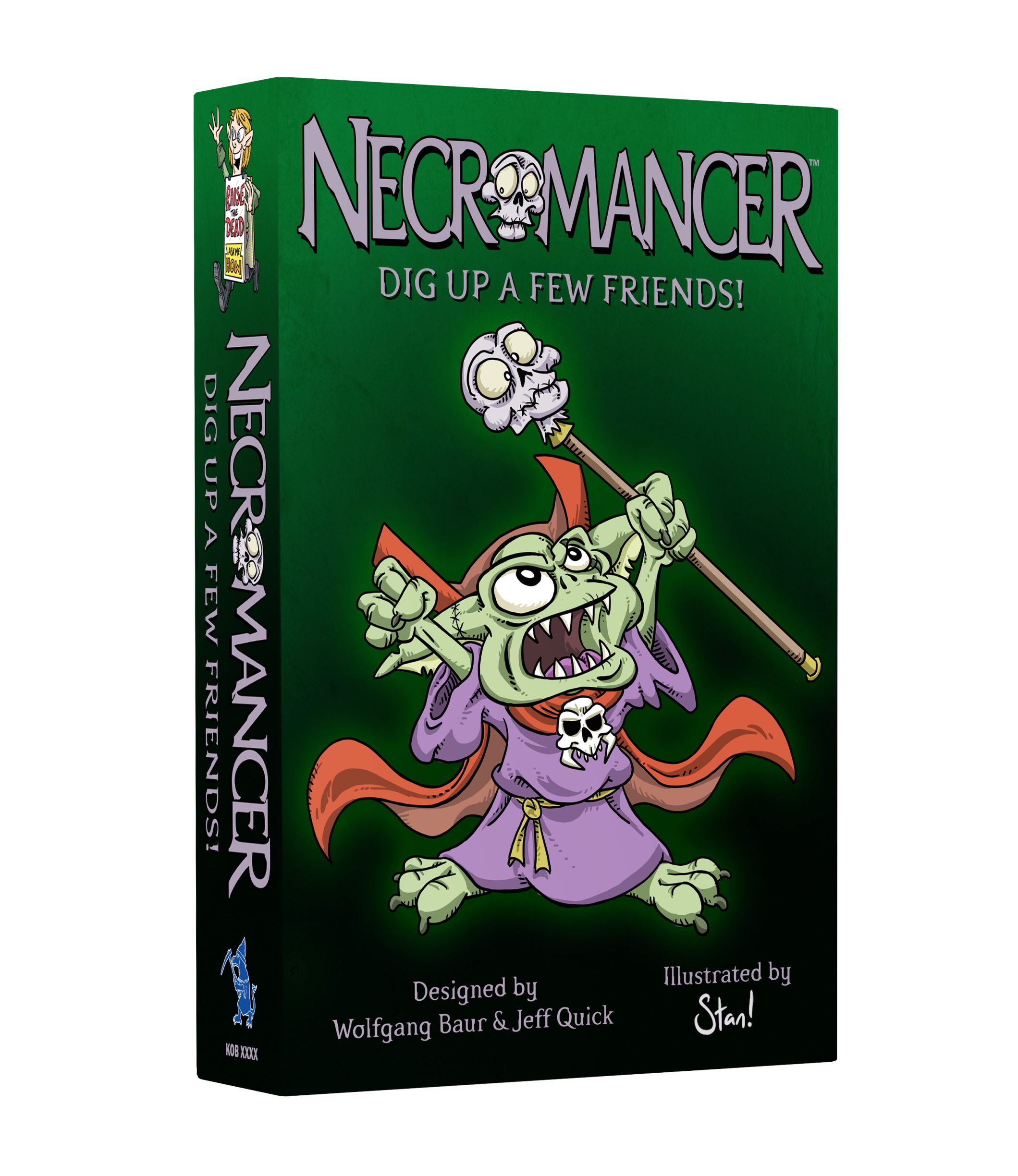
It’s October, a great time to add a dash of horror and gothic vibes to your tabletop sessions. While there’s plenty of terrors, horrors, and frights in the annals of Kobold Press Monster Vaults (1 and now featuring 2!), there’s always MORE.
Did you know Kobold Press made a card game this year, co-designed by Kobold-in-Chief Wolfgang Baur? It’s true! Necromancer is a silly, take-that game of sorcerers battling for supremacy.
Here’s a way to turn a game of Necromancer into the bones of a short campaign. Use this worldbuilding game idea for any fantasy board or card game!
What’s a Worldbuilding Game?
A worldbuilding game is a game you play, either by yourself or with some friends, that gives you the pieces to lay the foundations of a brand new setting or campaign. It can give you details about important NPCs, the history of your world, and add texture to pieces of it that you’ve already built.
Sure, you could spend days to weeks alone in your study, scrawling away like a mad wizard about the minute details of your precious world, but where’s the fun in that? (OK, we recognize that sounds fun for some people. You’re beautiful just the way you are.)
The Act of Play
The difference between coming up with a story whole-cloth and playing a game to help get you started is that the act of play changes how our brains work. When you have an idea of what you think will happen and that brushes up against the mechanics of a game, it prompts you to think in new ways, as you must adapt to the reality of the situation. This effect is multiplied once you aren’t just reacting to the mechanics of a game, but also the actions of your fellow players, as they are also reacting to the game. This is a collaborative act that allows you to draw inspiration from the ideas and energy of your fellow players and create something uniquely your table’s.
In addition to the game making it easier and more fun to create a new world, your players will feel a partial ownership of the world you end up making together. When details about an NPC they made up appear during the campaign, you can be sure they’ll tune in because it’s someone they already care about, and they’ll be excited to see where that character is now and what they’re doing. Your player will feel more invested in the setting.
Breaking down Necromancer

You might wonder, “How the heck do I use this card game to build a world?” Let’s break down Necromancer into its core parts and see what aspects you can bring into your world. Assuming the events of your Necromancer game are canon to your new world, then the following things must be true:
- Magic is real in your world. Necromancy, the art of manipulating the boundaries between life and death, is a way to practice magic.
- Powerful necromancers garner a cult-like following of minions who are willing to stand side by side with undead hordes to help the necromancer reach their ultimate goal.
- An arcane source of power known as the Well of Eternal Life exists, and these powerful necromancers want singular control over it. This Well will give them the power they need to reach their ultimate goal.
- There are two ways to win a game of Necromancer: sacrificing enough minions at the Well or being the first to have 15 Victory Points. This creates two potential starting points for your campaign. Either one of the factions already controls the Well of Eternal Life and is putting their final plan into motion, or they now have enough fighting power to take it soon.
With these facts in place, the game’s purpose becomes clear: your playthrough of a game of Necromancer determine who controls of the Well of Eternal Life (or who’s really close to it) at the start of your campaign. Playing the card game sets the stage and the stakes for your adventurers by playing the leaders of these necromantic factions and seeing where things end up. As a game master, you can then take the results of this game and weave them into your setting and build atop the foundations your players helped lay.
Preparing to Play
When using Necromancer as a worldbuilding game, the necromancer you choose is larger than the bounds of the card game. They have a history, a personality, and a goal. If you’re planning a campaign using a game like the Tales of the Valiant roleplaying game, you can create some of these details by noting what Lineage, Heritage, and Background your necromancer would be. You don’t have to get into the nitty-gritty of numbers and features for them just yet, but it can be a great place to start.
Next, determe the ultimate goal of your necromancer. The Well of Eternal Life is a tool to achieve some desired effect. Maybe your necromancer aims to ascend into lichdom or raise an ancient undead army of warriors to march on the nation’s capital. Regardless of the reason, the Well is a means to an end, not the end itself.
After each player chooses their Necromancer, take a moment to think about why they need the Well. You can roll a d6 on or pick from the What the Well Does for You table, or even come up with your own. The important thing is that the reason is a personal one and something they are willing to sacrifice innocent lives to accomplish.
What the Well Does for You
| d6 | The Well’s Value |
| 1 | You’ve lost a loved one that you refuse to live without. The Well of Eternal Life is the key to bringing them back, so the two of you can live together forever. |
| 2 | The archmages of the academy have ridiculed you for the last time. If they refuse to acknowledge your arcane prowess as their student, you’ll force them to as your army tears the academy down brick by brick. |
| 3 | Every night you dream of the Well. A voice, sweet as honey and as sharp as a bee’s sting, whispers to you from it. If you ever want to put a face to the voice, the Well must be yours. |
| 4 | The foolish lords of this land have bled it dry of its resources and its people. They are tyrants in silk clothing. The people are too weak to do anything about it, and so the task falls to you. Now, if only you had enough bodies to overpower the kingsguard. |
| 5 | Your reasons are simple: there simply isn’t enough time in your life to read all the books you want to read, to learn everything there is to learn. The greatest gift the Well offers is time. |
| 6 | You’ve grown tired of this liminal world, where things are born only to die. You’ve heard that the Well of Eternal Life could open a portal to a new realm where everything lasts forever, a realm where you could rule the undying for eternity. |
Playing the Game
Once you know who your necromancer is and why they desire the Well of Eternal Life, you’re ready to play a game of Necromancer. Play doesn’t change much. You can enjoy the fast-paced card game rules as written. However, consider the following to allow yourselves to fall into your character’s shoes and maybe have a bit more fun:
- Talk to your fellow players in character. Give your necromancer a unique voice and personality based on everything you know about them.
- Allow your necromancer to have biases and hold grudges. Sure, you could play the game “efficiently,” dead set on winning the game as quickly as possible. But maybe you’re still miffed that Ulvin took all of your zombies last turn, and you’d rather get back at him than move your remaining minions to the well to win.
- Take notes about how your necromancer feels about each of the other necromancers. Did an unlikely ally team up with you to spite a mutual enemy? Remember that. These details can help flesh out the relationships between these factions and NPCs in the campaign.
- If you have any particular minions or undead that stick around for a lot of the game, give them a name. Use that name whenever you call upon them to act in the game. This creates a personal connection to this card so that when they’re taken from you, destroyed, or sacrificed, it means something more than just another card removed from the board. And if they stick around to the end, maybe they’ll show up during the campaign!
Adding these details to your game might slow things down by a little bit, but in a game that can already be as short as 15–20 minutes, take another minute or two to call out The Black Knight for constantly targeting Celina, your ogre commander.
The Spoils of War
By the end of your game, you will have told a story of warring necromancers, sacrificing everything but themselves to accomplish their terrible goal. You’ll have faction conflicts with a history that you lived through, and hooks for the game master to use in the future.
If the game ends with one necromancer having sacrificed enough minions to control the Well, then your campaign may begin with the world feeling the adverse effects of someone gaining access to the Well’s power. Maybe the recently dead aren’t decomposing the way they should, or maybe the ground trembles at the weight of each sacrifice.
Whatever is happening is arcanely terrible and should be enough to spur the PCs into action (or at least get paid to investigate). The necromancers who failed to gain control of the Well in time might still be around, trying to subvert the winner’s plans as well, perhaps becoming tenuous allies with the party or just another antagonist looking to get in their way.
If your game ends with one necromancer having accrued enough Victory Points, then no one has control of the Well yet, but one faction is closer to its goal than the others and has the power to do it. With this ending, your campaign has more options when it comes to inciting incidents. Maybe the necromancer’s cult raids villages for potential sacrifices for the Well. Maybe they steal artifacts and knowledge to help them find the Well in the first place. The other factions are on the back foot, and may try more underhanded tactics to secure the Well before the larger faction has a chance to.
Regardless of how your game goes, take a moment to chat with your players and discuss how things went. Compare notes (if you took any) about how each character feels about the others, reminisce about dramatic turning points and what they would have looked like in your campaign world, and consider where your characters ended up after the dust has settled.
When all is said in done, now the game master has a host of characters, in-world conflicts, and some ideas for the stakes of your campaign once you all are ready to sit down and play again!
Read more at this site
